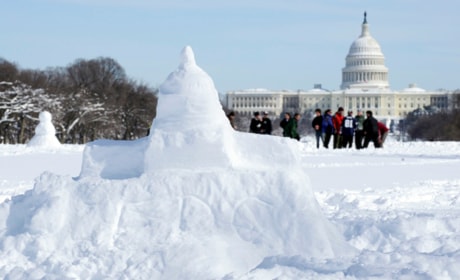WASHINGTON — Planes were grounded, trains stood still and Greyhound buses weren’t rolling in the Mid-Atlantic on Sunday, leaving stranded travellers wondering when they’ll be able to escape the icy, grey mess created by a major snowstorm.
Hundreds of thousands of homes were without power with temperatures below freezing all day, with utilities warning it could be days before it’s all restored.
Plows had scraped down to bare pavement on some main thoroughfares while not touching streets in many areas buried by 60 centimetres or more.
In the nation’s capital, meanwhile, Monday will be another day for residents to get back to normal.
The federal government made the decision to close agencies today, and many school districts across the region were giving students a snow day.
For those stranded, however, the thought of another day of weekend wasn’t much to smile about.
Joel Jones of Durham, North Carolina, said he was on a bus from Baltimore on Friday. When he arrived in Washington, the rest of the trip was cancelled.
He walked to Union Station to get a train, where he has remained, sleeping on chairs.
“I’m starting to worry because I take insulin,” said the 41-year-old, who has diabetes. “I got enough for like one more shot, so I have enough until tomorrow. Hopefully, I’ll get on the bus in the morning.”
The National Weather Service called the storm “historic” and reported 30 centimetres of snow in parts of Ohio and 60 centimetres or more in Washington, Delaware, New Jersey and Pennsylvania. Parts of Virginia, Maryland and West Virginia got closer to 90 centimetres.
Many roads reopened but officials continued to warn residents that highways were still icy, a remnant from the storm President Barack Obama called “Snowmageddon.”
In Washington, the sun was finally shining Sunday and the sounds of shovels could be heard on streets.
In contrast to Saturday, when people were frolicking on the barren streets, thoughts turned Sunday to cleanup.
The snow snapped tree limbs onto power lines, and several roofs collapsed under the weight.
Making matters worse, the weather service issued a storm watch for Tuesday.
Some people without electricity worried whether the power would return in time for Sunday night’s Super Bowl kickoff — though it was an afterthought for others just trying to stay warm.
Julia Nickles-Bryan and her husband, Charles Bryan, were more focused on keeping their twin 7-year-old daughters warm inside their Baltimore home — where the thermostat read 47 degrees (8.3 Celsius). All they had for heat was a gas stove, gas water heater and a fire in the fireplace.
“We’re basically camping,” Nickles-Bryan said.
Bill McKenzie, 42, a government contractor from San Antonio, Texas, was staying at a hotel near BWI Airport in Elkridge, Maryland, when the snow hit. He had planned to watch the Super Bowl with friends in the area, but the storm made that impossible. He spent Saturday at a sports bar next to his hotel and was back for much of the day Sunday to watch the game.
“It’s a godsend,” McKenzie said. “If this place wasn’t here, we’d all be starving to death.”
In Philadelphia, 28.5 inches (72 centimetres) of snow fell during the storm, just shy of the record 30.7 inches (78 centimetres) during the January 1996 blizzard. Snow totals were even higher to the west in Pennsylvania.
Officials at Washington’s Reagan National Airport, which had cancelled all flights, hasn’t decided when flights would resume. At nearby Dulles International Airport in Virginia, some flights have resumed.
